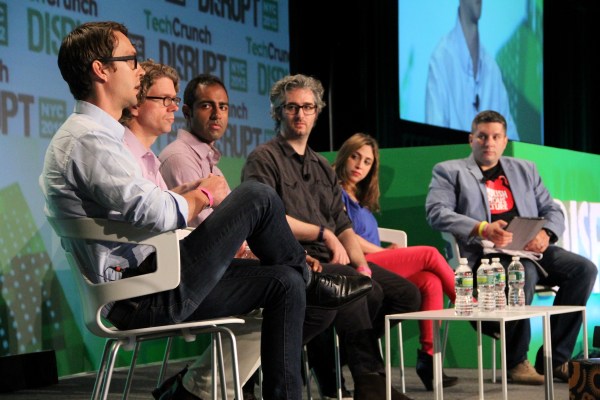Earlier this morning, our own John Biggs was joined on stage by a handful of New York-based makers who have made a name for themselves by building physical things (or in one case, building something that builds other things). Biggs kicked off the panel with a simple question: — can we bring manufacturing back?
Bre Pettis, CEO of Makerbot Industries, has two shifts of workers putting together all of his Makerbots in Brooklyn, and had a bit of advice for hardware creators looking to shift production to China. He recommended that until makers need to produce runs of 50,000-100,000 units, they’re much better off keeping the production process in the United States. It helps to keep makers intimate with their tech, not to mention makes it easier for them to handle any unexpected issues faster.
The process of launching a product was tackled too — interestingly enough, Amol Sarva of Peek fame revealed that if he had to take his email gadget to market now instead of a few years ago, he would’ve gone a completely different route. Instead of going big and pushing to get his devices on store shelves around the country, he instead would have gone with the grassroots approach — making a few devices and trying to build buzz around them.
Another recurring theme of the panel was the notion that makers should embrace niches.
“There may not be mass market ideas, and that’s OK,” said Peter Semmelhack of Bug Labs. He noted that people can put hardware and devices together that aren’t meant to reach millions and millions of people (they could even use a Makerbot if the production run size was modest enough), and these small markets were still worth going after.
Plus, you can never really tell just how niche some niches are. Duncan Frazier of Bit Banger Labs knows that all too well — he and his team developed a sleep mask that aims to help its users lucid dream, and put together a Kickstarter campaign for it. They expected they would have to make a few hundred units at most, but the niche was much bigger than they thought. By the time their campaign was over, they had exceeded their $35,000 funding request by orders of magnitude.
The discussion then turned to the question of whether or not we could build something akin to a sprawling Foxconn campus in somewhere like Iowa.
“Here in the U.S., as a culture, we’re not really focused on [manufacturing],” Pettis noted. “Our children are the only priority lower than manufacturing.”
There was little question that using Chinese facilities for manufacturing has its advantages — namely sheer output — but some were curious as to how long that would remain the case. Pettis pointed out that wages in China have doubled over the last year, a trend that (if continued) may eventually lead to a shift away from relying on China.
The panel ended on a slightly more inspirational note, with each of makers chiming in with advice for young upstarts who want to start making things. On this, everyone seemed to agree — the best approach is to just go out there and start going it. Ayah Bdeir, CEO of littleBits, specifically pointed out that a young person who had $50 and an Internet connection had no shortage of places to turn for inspiration — Instructables and Hack A Day, for instance.
“You learn by making,” she said. Pettis recommended that wannabe makers should just “jump in” to the process, and if they eventually decide to go the Kickstarter route, Frazier emphasized the importance of a solid video because that’s the only place the product exists as far as the users are concerned.

